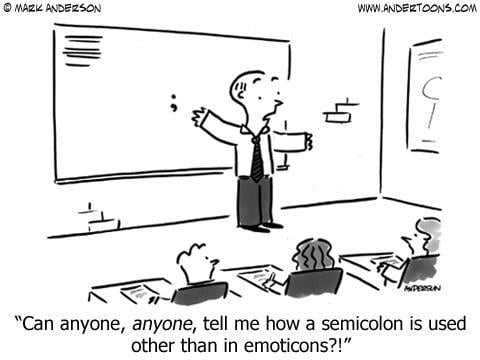Hashtag Rappers & the Semicolon
Have you heard of The Lonely Island? They’re a musical comedy trio. I hadn’t heard of them until recently when my younger brother sent me a video of theirs. “Check it out,” he said, “it seems like something you’d enjoy.” The video was called “SEMICOLON” and starts with a teacher introducing the subject only to be interrupted by a member of The Lonely Island.
“We use semicolons every day.”
“Can you give me an example?”
“Oh, h*** yeah!”
My brother had been right, I loved it. What followed was a hashtag rap (refers to the recent rise in rap lines which drop the usage of “like” and “as”, and instead substitute those words with pregnant pauses. What results is a truncation of what is normally a simile or metaphor into a sort of short setup followed by a punch line. Take, for example, this line by the rapper Drake: “Swimming in the money, come and find me: Nemo.”) humorously misusing semicolons.
The song is comprised of lines claiming there is a semicolon where, in actuality, a colon should reside:
“I’m the motherf***ing monster (semicolon) cookie”
This line should read “I’m the motherf***ing monster: cookie”. But, why?
Using Semicolons
Kurt Vonnegut famously avoided semi-colons in all his works, complaining that “all they do is show you’ve been to college.” But the rules for semicolon use aren’t as complicated as some think; they are easy and few.
· Most commonly, semicolons separate two main clauses that are closely related to each other but that could stand on their own as sentences if you wanted them to. When you use a semicolon in this manner, the main clauses should be closely related to each other.
Susie seldom ate cake; she isn’t a fan of frosting.
· You can also use a semicolon when you use a conjunctive adverb to join two main clauses. Conjunctive adverbs such as “however”, “therefore”, and “indeed” indicate the nature of the relationship between the two clauses (i.e., to show cause and effect, contrast, or other relationships).
I’ve never liked the color green; however, on you it looks lovely.
· Semicolons can also be used to when compiling a list whose individual items contain commas.
Mark has traveled to Phoenix, Arizona; Boston, Massachusetts; and Newport, Rhode Island.
· Lastly, you can use a semicolon to replace a comma in a sentence separating two independent clauses connected by a coordinating conjunction (and, or, but, etc.) when the independent clauses are complex or lengthy and when there are commas within those independent clauses. When this happens you may want to remove the coordinating conjunction and separate the clauses into separate sentences, but that’s a stylistic decision best left to the writer.
It was a beautiful day, sunny with a slight breeze, stereotypical of this time of year; it was a perfect day to try waterskiing, jet skiing, or any watersport available in the area.
Semicolons vs. Colons
The way the song confuses colons with semicolons is a common mistake. Generally the purpose of a colon is to introduce or define something. But the difference between using a colon and a semicolon is that you use a semicolon to join clauses they must be able to stand alone as sentences, whereas a complete clause doesn’t have to follow the colon.
See, that wasn’t so hard, now was it? I should mention that at the end of the song the teacher points out the fact that the rappers are using semicolons incorrectly and gives them failing grades. Too bad they didn’t know how to properly use “a comma and a f***ing dot: semicolon” (their words, not mine).
What’s your opinion on semicolons? Can you think of any other punctuation deserving of a song?


